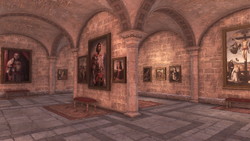- "I have created a small gallery in the Villa. Monteriggioni's artists are always welcome to study them."
- ―Mario Auditore regarding the Villa's gallery, 1454.[src]
A painting gallery is a space for the exhibition of paintings. During the Italian Renaissance, the Assassin Ezio Auditore would store and showcase paintings in galleries.
Villa Auditore
The painting gallery in the Villa Auditore
At some point during 1454, Mario Auditore created a painting gallery in the Villa, taking advantage of his brother's connections in Florence to import fine art.[1]
From 1476 to 1499, his nephew Ezio gathered pieces of Renaissance artwork from art merchants in several different cities during his travels, which were displayed in the villa's painting gallery. However, the paintings were either destroyed or stolen by the Borgia following the siege of Monteriggioni in 1500.[2][3]
Thanks to his friendship with the artist Leonardo da Vinci, Ezio Auditore was also able to gather a large number of his works, including the Annunciation, Lady with an Ermine, and the Portrait of a Musician.[2]
Tiber Island headquarters

The painting gallery in the Tiber Island headquarters
After having obtained an old storeroom on Tiber Island from Fabio Orsini, the Assassin Order re-decorated a room to house a painting gallery.[3]
Ezio once again gathered paintings, sold by art merchants throughout Rome - all of which were the works of Raphael. Additionally, portraits of primary assassination targets were displayed in the same gallery.[3]
Trivia
- Several paintings which Ezio could buy both before and after settling to Rome were historically created at a later time. For example, Antonio Allegri da Correggio was born in 1489 and painted Jupiter and Io in 1530, yet Ezio could acquire this painting as early as 1481.
- During the restored memory A Roll of the Dice, Salaì revealed to Ezio that only two works among the six by Leonardo were burnt during the fall of Monteriggioni (2 January 1500): Leda and Saint John the Baptist. Historically, these two works were painted between 1505 and 1516.
- At the end of The Temple of Pythagoras, Leonardo told Ezio that he meant to repaint the Saint John lost in the Villa fire. Thus it is possible that the two paintings historically created between 1505 and 1516 were both copies of the lost originals.
- During the restored memory A Roll of the Dice, Salaì revealed to Ezio that only two works among the six by Leonardo were burnt during the fall of Monteriggioni (2 January 1500): Leda and Saint John the Baptist. Historically, these two works were painted between 1505 and 1516.
References

| |||||||||||||||||||||||||||||||||||||
